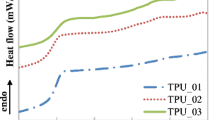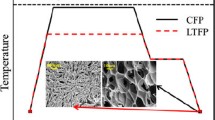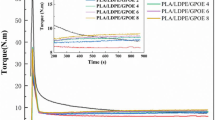Abstract
Currently, preparing nanocellular semi-crystalline polymer foams by supercritical CO2 is a big and newly developing challenge. In this paper, chain extender (CE) and hydroxyl-functionalized graphene (HG) were introduced into poly(lactic acid) (PLA) through melt blending method to improve the crystallization behaviors, rheological properties and foaming behaviors of PLA. Differential scanning calorimetry results showed that the cold crystallization temperature of chain extended PLA (CPLA)/HG was higher 8.2 °C than that of CPLA, due to the introduction of HG and the strong interaction between CPLA and HG. The viscoelasticity of PLA was improved by the addition of CE and HG, due to the formation of branching structure and the interaction between CPLA and HG. Compared with that in PLA/HG, HG aggregation in CPLA/HG became many but small, indicating that the aggregation of HG in the matrix released. A facile batch foaming method with constant foaming temperature slightly lower than melting temperature was employed to fabricate nanocellular PLA foams in the presence of supercritical CO2. The transition temperature from microcells to nanocells in various PLA foams was confirmed. The effect of chain extension, foaming temperature and the introduction of HG on cell size, cell density, cell size distribution and volume expansion ratio (VER) was studied systematically. For the CPLA/HG foam prepared at 130 °C, its cell size could reach 350 ± 247 nm as well as its cell density and VER were 1.76 × 1013 cells/cm3 and 3.71 ± 0.16 times, respectively. Finally, the foaming mechanism for the nanocell formation was proposed and explained by schematic diagram.












Similar content being viewed by others
References
Okolieocha C, Raps D, Subramaniam K, Altstadt V (2015) Microcellular to nanocellular polymer foams: progress (2004–2015) and future directions—a review. Eur Polym J 73:500–519
Muanchan P, Ito H (2018) Nanocellular foams confined within PS microfibers obtained by CO2 batch foaming process. Microsyst Technol 24:655–662
Nofar M, Park CB (2014) Poly(lactic acid) foaming. Prog Polym Sci 39:1721–1741
Yeh SK, Chen YR, Kang TW et al (2018) Different approaches for creating nanocellular TPU foams by supercritical CO2 foaming. J Polym Res 25:30
Leon MD, Bernardo V, Rodriguez-Perez MA (2017) Key production parameters to obtain transparent nanocellular PMMA. Macromol Mater Eng 302:1700343
Luo Y, Ye C (2012) Using nanocapsules as building blocks to fabricate organic polymer nanofoam with ultra low thermal conductivity and high mechanical strength. Polymer 53:5699–5705
Forest C, Chaumont P, Cassagnau P, Swoboda B, Sonntag P (2015) Polymer nano-foams for insulating applications prepared from CO2 foaming. Prog Polym Sci 41:122–145
Ling J, Zhai W, Feng W, Shen B, Zhang J, Zheng WG (2013) A facile preparation of lightweight microcellular polyetherimide/graphene composites foams for electromagnetic interference (EMI) shielding. Acs Appl Mater Interfaces 5:2677–2684
Gaspard S, Oujja M, Nalda RD, Castillejo M, Banares L, Lazare S, Bonneau R (2008) Nanofoaming dynamics in biopolymers by femtosecond laser irradiation. Appl Phys A 93:209–213
Reignier J, Huneault MA (2006) Preparation of interconnected poly(3-caprolactone) porous scaffolds by a combination of polymer and salt particulate leaching. Polymer 47:4703–4717
Hong SM, Hwang SS (2006) A nanofoaming process and dielectric properties of polymethylphenylsilsesquioxane-based nanofoams. J Appl Polym Sci 100:4964–4971
Costeux S (2014) CO2-blown nanocellular foams. J Appl Polym Sci 41293:1–16
Costeux S, Zhu L (2013) Low density thermoplastic nanofoams nucleated by nanoparticles. Polymer 54:2785–2795
Guo H, Kumar V (2015) Some thermodynamic and kinetic low-temperature properties of the PC-CO2 system and morphological characteristics of solid-state PC nanofoams produced with liquid CO2. Polymer 56:46–56
Tiwary P, Park CB, Kontopoulou M (2017) Transition from microcellular to nanocellular PLA foams by controlling viscosity, branching and crystallization. Eur Polym J 91:283–296
Yi XJO, Lai YL, Davoodi P, Wang CH (2018) Production of drug-releasing biodegradable microporous scaffold using a two-step micro-encapsulation/supercritical foaming process. J Supercrit Fluid 133:263–269
Lee ST (2004) Thermoplastic foam processing: Principles and development. CRC Press, Boca Raton
Zhao H, Cui Z, Wang X, Turng LS, Peng X (2013) Processing and characterization of solid and microcellular poly(lactic acid)/polyhydroxybutyrate-valerate (PLA/PHBV) blends and PLA/PHBV/Clay nanocomposites. Compos Part B Eng 51:79–91
Wang X, Liu W, Zhou H, Liu B, Li H, Du Z, Zhang C (2013) Study on the effect of dispersion phase morphology on porous structure of poly(lactic acid)/poly(ethylene terephthalate glycol-modified) blending foams. Polymer 54:5839–5851
Lu X, Tang L, Wang L, Zhao J, Li D, Wu Z, Xiao P (2016) Morphology and properties of bio-based poly(lactic acid)/high-density polyethylene blends and their glass fiber reinforced composites. Polym Test 54:90–97
Wang Z, Ding X, Zhao M, Wang X, Xu G, Xiang A, Zhou H (2017) A cooling and two-step depressurization foaming approach for the preparation of modified HDPE foam with complex cellular structure. J Supercrit Fluid 125:22–30
Mihai M, Huneault MA, Favis BD, Li H (2007) Extrusion foaming of semi-crystalline PLA and PLA/thermoplastic starch blends. Macromol Biosci 7:907–920
Chen P, Zhou H, Liu W, Zhang M, Du Z, Wang X (2015) The synergistic effect of zinc oxide and phenylphosphonic acid zinc salt on the crystallization behavior of poly(lactic acid). Polym Degrad Stab 122:25–35
Liu W, Chen P, Wang X, Wang F, Wu Y (2017) Effects of poly(butyleneadipate-co-terephthalate) as a macromolecular nucleating agent on the crystallization and foaming behavior of biodegradable poly(lactic acid). Cell Polym 36:75–96
Nerkar M, Ramsay JA, Ramsay BA, Kontopoulou M (2015) Dramatic improvements in strain hardening and crystallization kinetics of PLA by simple reactive modification in the melt state. Macromol Mater Eng 299:1419–1424
Bouakaz BS, Habi A, Grohens Y, Pillin I (2017) Organomontmorillonite/graphene-PLA/PCL nanofilled blends: new strategy to enhance the functional properties of PLA/PCL blend. Appl Clay Sci 139:81–91
Zhao JC, Du FP, Zhou XP et al (2011) Thermal conductive and electrical properties of polyurethane/hyperbranched poly(urea-urethane)-grafted multi-walled carbon nanotube composites. Compos Part B Eng 42:2111–2116
Zhou H, Wang X, Du Z, Li H, Yu K (2015) Preparation and characterization of chain extended poly(butylene succinate) foams. Polym Eng Sci 55:988–994
Wang X, Zhang Y, Liu B, Du Z, Li H (2008) Crystallization behavior and crystal morphology of linear/long chain branching polypropylene blends. Polym J 40:450–454
Sullivan EM, Yun JO, Gerhardt RA, Wang B, Kalaitzidou K (2014) Understanding the effect of polymer crystallinity on the electrical conductivity of exfoliated graphite nanoplatelet/polylactic acid composite films. J Polym Res 21:563
Qi F, Tang M, Chen X, Chen M, Guo G, Zhang Z (2015) Morphological structure, thermal and mechanical properties of tough poly(lactic acid) upon stereocomplexes. Eur Polym J 71:314–324
Pantani R, Santis FD, Sorrentino A, Maio FD, Titomanlio G (2010) Crystallization kinetics of virgin and processed poly(lactic acid). Polym Degrad Stabil 95:1148–1159
Zhao M, Ding X, Mi J, Zhou H, Wang X (2017) Role of high-density polyethylene in the crystallization behaviors, rheological property, and supercritical CO2 foaming of poly(lactic acid). Polym Degrad Stab 146:277–286
Kuang TR, Mi HY, Fu DJ, Jing X, Chen BY, Mou WJ, Peng XF (2015) Fabrication of poly(lactic acid)/graphene oxide foams with highly oriented and elongated cell structure via unidirectional foaming using supercritical carbon dioxide. Ind Eng Chem Res 54:758–768
Wang X, Zhou H, Liu B, Du Z, Li H (2015) Chain extension and foaming behavior of poly(lactic acid) by functionalized multiwalled carbon nanotubes and chain extender. Adv Polym Technol 33:21444
Chen L, Rende D, Schadler LS, Ozisik R (2013) Polymer nanocomposite foams. J Mater Chem A 1:3837–3850
Mihai M, Huneault MA, Favis BD (2010) Rheology and extrusion foaming of chain-branched poly(lactic acid). Polym Eng Sci 50:629–642
Kolodka E, Wang W, Zhu S, Hamielec AE (2004) Rheological and thermomechanical properties of long-chain-branched polyethylene prepared by slurry polymerization with metallocene catalysts. J Appl Polym Sci 92:307–316
Rajagopalan G, Immordino KM Jr, Gillespie JW, Mcknight SH (2000) Diffusion and reaction of epoxy and amine in polysulfone studied using fourier transform infrared spectroscopy: experimental results. Polymer 41:2591–2602
Liu C, Ye S, Feng J (2017) Promoting the dispersion of graphene and crystallization of poly(lactic acid) with a freezing-dried graphene/PEG masterbatch. Compos Sci Technol 144:215–222
Li K, Cui Z, Sun X, Turng LS, Huang H (2011) Effects of nanoclay on the morphology and physical properties of solid and microcellular injection molded polyactide/poly(butylenes adipate-co-terephthalate) (PLA/PBAT) nanocomposites and blends. J Biobased Mater Bioenergy 5:442–451
Najafi N, Heuzey MC, Carreau PJ, Therriault D, Park CB (2014) Rheological and foaming behavior of linear and branched polylactides. Rheol Acta 53:779–790
Zhang Y, Tiwary P, Parent JS, Kontopoulou M, Park CB (2013) Crystallization and foaming of coagent-modified polypropylene: nucleation effects of cross-linked nanoparticles. Polymer 54:4814–4819
Nofar M, Guo Y, Park CB (2013) Double crystal melting peak generation for expanded polypropylene bead foam manufacturing. Ind Eng Chem Res 52:2297–2303
Nofar M, Zhu W, Park CB (2012) Effect of dissolved CO2 on the crystallization behavior of linear and branched PLA. Polymer 53:3341–3353
Liu H, Wang X, Zhou H, Liu W, Liu B (2015) The Preparation and characterization of branching poly(ethylene terephthalate) and its foaming behavior. Cell Polym 34:63–94
Colton JS, Suh NP (1987) Nucleation of microcellular foam: theory and practice. Polym Eng Sci 27:500–503
Funding
This study was funded by the National Natural Science Foundation of China (51673004 and 51703004), the Natural Science Foundation of Beijing Municipality (2162012) and Top Young Innovative Talents Program of Beijing Municipal University (CIT&TCD201704041).
Author information
Authors and Affiliations
Corresponding authors
Ethics declarations
Conflict of interest
The authors declare that they have no competing interests.
Rights and permissions
About this article
Cite this article
Wang, X., Mi, J., Zhou, H. et al. Transition from microcellular to nanocellular chain extended poly(lactic acid)/hydroxyl-functionalized graphene foams by supercritical CO2. J Mater Sci 54, 3863–3877 (2019). https://doi.org/10.1007/s10853-018-3120-8
Received:
Accepted:
Published:
Issue Date:
DOI: https://doi.org/10.1007/s10853-018-3120-8




